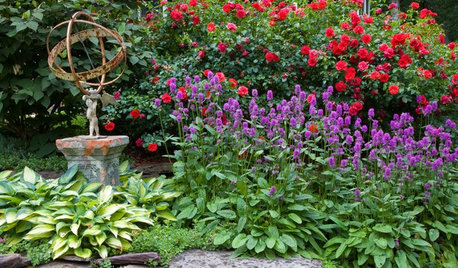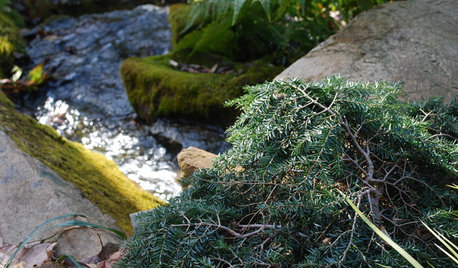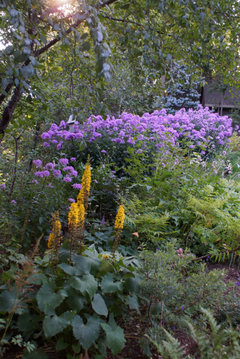Report: Black Walnut Rose Plantings
Hawkeye_Belle
20 years ago
Featured Answer
Sort by:Oldest
Comments (28)
westover
20 years agoHawkeye_Belle
20 years agoRelated Discussions
Red Majestic and Rose Mallow near Black Walnut?
Comments (4)Dear CadillacTaste - I am wondering if you did try this and if the "Red Majestic" lived in proximity to a black walnut. I'm assuming the previous responder based the assurance on the fact that corylus americanus should be juglone resistant, but most lists seem to specify American hazelnuts, which evolved in proximity to black walnuts, and the specificity of listing American hazelnut (corylus) makes me wonder before I try my contorted hazelnut / corylus contorta / Harry Lauder's walking stick near a black walnut if perhaps the European cousin might Not be resistant to juglone. I have had the same question with regard to the various hybiscus family members, too, by the way ... are they all resistant or just some?...See More?sun plants in and or around the black walnut
Comments (7)Forget about the lavendar and sage. These are too toxic prone and lavendar is a short lived plant anyway. Your daisies and cone flowers and black-eyed susans will do just fine. So will daylilies and probably lilies. I know for sure that siberian iris will grow. But try the bearded ones too. If you have tested the soil RECENTLY with tomato plants then you don't have a problem with the toxin. However, roots grow; so I would test again if you want to plant sensitive plants in that spot. As for my roses, they all gave a good spring flush but have not grown much since then and have had very sparse rebloom. However, they also don't get a lot of sun. I'm inclined to think that is the cause of sparse bloom. They are otherwise healthy, except one--Daybreak. It died last winter. There were a number of roots invading its space. As to whether or not to get rid of the trees, there are enough plants that will grow within the root zone of these trees to make them worth keeping. On the other hand, as StephenB says, they are messy plants. At least mine are. If your space is small, they certainly would not be my choice for home landscapes. Because they are messy, they require constant cleanup-leaves, branches, stems and the nuts, well there are times one cannot walk on that side of the yard because there are so many nuts. It is a hazard; the nuts are very slippery and if one should fall on your head--OUCH. They also stain-walnut stain was once made from the hulls. In the end it is a highly personal decision as to whether to keep or not. I keep because my neighbors have them growing along my property line so there would be very little difference in the toxin levels. The toxin also stays in the soil at least 5 years after the tree is gone due to decaying roots....See MoreQuestion about black walnut (juglone) toxicity and roses
Comments (1)I live on a street where the street trees are huge, 100 year old black walnut trees. I have grown roses (about 30 in that area) and bulbs, and ground cover plants under them over an area of about 100 feet long by 15 feet deep for 25 years. Everything thrived - no problems at all, except that I have to pull up black walnut seedlings a lot! Evidently they like the flower beds to germinate in! Jackie...See MoreGrowing roses near black walnut trees
Comments (2)Our farm came with mature Black Walnut trees. No way we were cutting them down. We have two black walnuts near my tree sized R. x Fortuniana. They've lived together for almost fifteen years. IF you live where roses grafted onto R. x Fortuniana can survive, you may want to try some. I can't, for reasons I've detailed here other times. Second experiences are with so-called Hybrid Musks own root as well as a couple of climbers grafted onto R. multiflora rootstock. The hybrid Musks (early ones -closer to their progenitor R. multiflora) lasted about ten years. The climbers on R. multiflora rootstock have survived more than twenty years. (You may want to look at Palatine's offerings from Canada as they sell roses on multiflora rootstock.)...See MoreHawkeye_Belle
20 years agowestover
20 years agolisaloo
20 years agolaboopsie
20 years agoHawkeye_Belle
20 years agonakara
20 years agoHawkeye_Belle
19 years agopennycp
19 years agoHawkeye_Belle
19 years agopennycp
19 years agoPaula_sfbay
19 years agoHawkeye_Belle
19 years agoMissy_Va
19 years agoHawkeye_Belle
19 years agoorganic_joans
15 years agobbinpa
15 years agodottie_in_charlotte
15 years agoDiana195011
9 years agoCarmina Burana
5 years agoChristy Assid
4 years agolast modified: 4 years agoBegonia Begonia
2 years agomarsha l
2 years agolast modified: 2 years agoBegonia Begonia
2 years agomarsha l
2 years agoBegonia Begonia
2 years ago
Related Stories

PLANTING IDEASGreat Garden Combo: Rose + Clematis for Small-Space Impact
We all need somebody to lean on. And when a rose supports a climbing vine, the results can totally transform a small garden
Full Story
GARDENING GUIDESGreat Design Plant: Stachys Officinalis ‘Hummelo’
The adaptable ‘Hummelo’ betony adds jolts of color to a sunny border or woodland edge
Full Story
GARDENING GUIDESGreat Design Plant: Silphium Perfoliatum Pleases Wildlife
Cup plant provides structure, cover, food and water to help attract and sustain wildlife in the eastern North American garden
Full Story
GARDENING GUIDESGreat Design Plant: Tsuga Canadensis ‘Bennett’
Bennett Canadian hemlock thrives in shade and provides sculptural interest in eastern U.S. gardens
Full Story
SPRING GARDENINGTop 10 Scented Plants for Your Garden
A palette of perfumed plants can transform even the smallest of gardens into a sensory delight
Full Story
GARDENING GUIDESGreat Garden Combo: 3 Wonderful Plants for a Deer-Resistant Screen
Protect your privacy and keep deer at bay with a planting trio that turns a problem garden area into a highlight
Full Story
GARDENING FOR BIRDSFeed the Birds: 6 Plants for Abundant Winter Berries
Be kind to your fair feathered friends during lean food times by planting a shrub or tree loaded with nutritious snacks
Full Story
GARDENING GUIDESHow to Find the Right Native Plants for Your Yard
Find plant maps, sale sites and guides that make going native in the garden easier than ever
Full Story
GARDENING FOR BUTTERFLIES3 Ways Native Plants Make Gardening So Much Better
You probably know about the lower maintenance. But native plants' other benefits go far beyond a little less watering and weeding
Full Story
GARDENING GUIDES10 Top Native Plants for the U.S. Southeast
For a low-maintenance and wildlife-friendly landscape, use Southern natives that withstand heat and humidity
Full Story



westover